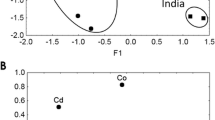Abstract
Twenty different brands of Chinese tea were analyzed for multiple trace elements, including some essential and toxic elements, by neutron activation analysis (NAA). A comparison among tea brands from China, India, US and other countries was made for the ranges and averages of concentrations for Na, K, Mn, Cu, and Br. It has been observed that the trace element contents in tea leaves are largely dependent upon the soil and the environment where the tea grows. Chinese tea is rich in Mn and Cu comparing with those of other counties surveyed, but is indigent in Na. The transference ratio for each element determined (i.e., the fraction of an element in tea leave transferred into solution when tea is leached by percolation) is also reported. Adult daily intakes of some essential and toxic elements from tea drinking were also estimated.


Similar content being viewed by others
References
O’Dell BL, Sunde RA (1997) Handbook of nutritionally essential mineral elements. Marcel Dekker, New York, p 1
Kumar A, Nair AGC, Reddy AVR, Garg AN (2005) Availability of essential elements in Indian and US tea brands. Food Chem 89:441–448
Jonah SA, Williams IS (2000) Nutrient elements of commercial tea from Nigeria by an instrumental neutron activation analysis technique. Sci Total Environ 258:205–208
Hewitt EJ, Smith TA (1975) Plant mineral nutrition. The English University Press, London
Ozdemir Y, Gucer S (1998) Speciation of manganese in tea leaves and tea infusions. Anal Lett 31:679–689
Lamble K, Hill SJ (1995) Determination of trace metals in tea using both microwave digestion at atmospheric pressure and inductively coupled plasma atomic emission spectrometry. Analyst 120:413–417
Manahan SE (1984) Environmental chemistry, 4th edn. Brookes/Cole, Monterey, p 363
Balaji T, Acharya RN, Nair AGC, Reddy AVR, Rao KS, Naidu GRK, Manohar SB (2000) Determination of essential elements in ayurvedic medicinal leaves by k0 standardized instrumental NAA. J Radioanal Nucl Chem 243:783–788
Bollard EG, Butler GW (1966) Mineral nutrition of plants. Annu Rev Plant Physiol 17:77–112
Price CA (1968) Iron compounds and plant nutrition. Annu Rev Plant Physiol 19:239–248
Food and Nutrition Board (1980) Recommended dietary allowances, 9th edn. National Academy of Sciences, Washington, DC, p 154
Costa M (2003) Potential hazards of hexavalent chromate in our drinking water. Toxicol Appl Pharmacol 188:1–5
Dayan AD, Payne AJ (2001) Mechanisms of chromium toxicity, carcinogenicity and allergenicity: review of the literature from 1985 to 2000. Hum Exp Toxicol 20:439–451
Majumdar KK, Guha MDN, Ghose N, Ghose A, Lahiri S (2009) Systemic manifestations in chronic arsenic toxicity in absence of skin lesions in West Bengal. Indian J Med Res 129:75–82
Harvey SC (1965) Pharmacological basis of therapeutics, 3rd edn. Macmillan, New York, p 943
Tanner JT, Freedman MH (1977) J Radioanal Chem 37:529–538
Mcbride BC, Wolfe RS (1971) Biochemistry 10:4312–4317
Author information
Authors and Affiliations
Corresponding author
Rights and permissions
About this article
Cite this article
Zhang, HQ., Ni, BF., Tian, WZ. et al. Study on essential and toxic elements intake from drinking of Chinese tea. J Radioanal Nucl Chem 287, 887–892 (2011). https://doi.org/10.1007/s10967-010-0921-x
Received:
Published:
Issue Date:
DOI: https://doi.org/10.1007/s10967-010-0921-x




